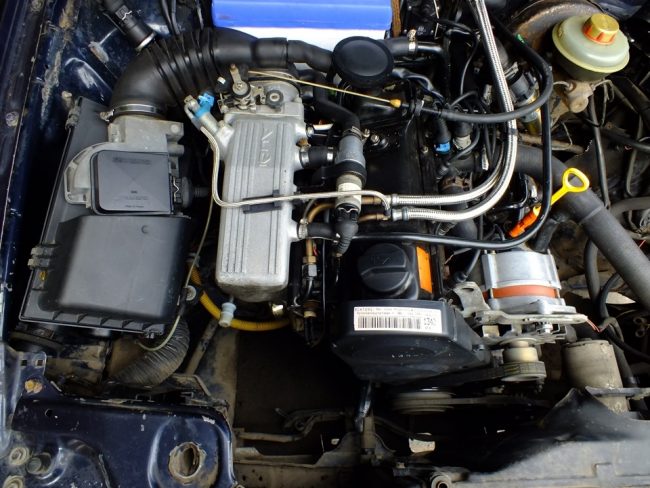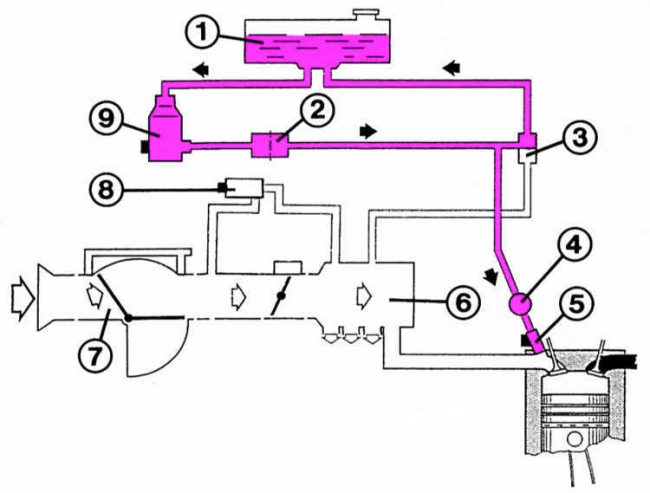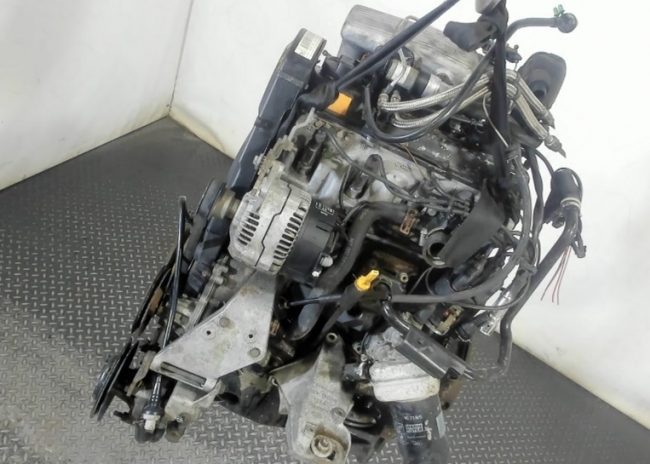
Audi ABK engine
Content
For the Audi models of the VAG auto concern, popular in the 90s, a power unit was created that fully meets the increased specific requirements. He completed the line of Volkswagen engines EA827-2,0 (2E, AAD, AAE, ABF, ABT, ACE, ADY, AGG).
Description
The Audi ABK engine was developed and put into production in 1991. Its main purpose is to equip Audi 80 B4, 100 C4 and A6 C4 cars with a longitudinal layout in the power compartment.
The release of the motor continued until 1996 inclusive. When designing the internal combustion engine, the engineers of the concern took into account and finalized the shortcomings that were present on previously produced engines of this class.
The Audi ABK engine is nothing more than a 2,0-liter gasoline in-line four-cylinder aspirated engine with a capacity of 115 hp. with and a torque of 168 Nm.

Installed on market-demanded Audi models:
- Audi 100 Avant /4A, C4/ (1991-1994);
- 100 sedan /4A, C4/ (1991-1994);
- 80 Before /8C, B4/ (1992-1996);
- 80 sedan /8C, B4/ (1991-1996);
- A6 Avant /4A, C4/ (1994-1997);
- A6 sedan /4A, C4/ (1994-1997);
- Cabriolet /8G7, B4/ (1993-1998);
- Cup /89, 8B/ (1991-1996).
The design of the cylinder block is a well-proven and successfully proven trade wind: made of cast iron, with an intermediate shaft inside. The purpose of the shaft is to transmit rotation to the ignition distributor and the oil pump.
Aluminum pistons with three rings. Two upper compression, lower oil scraper. Steel thermostatic plates are inserted into the bottoms of the pistons.
The crankshaft is fixed in five main bearings.
Aluminum cylinder head. A camshaft (SOHC) is located on top, and eight valve guides are pressed into the body of the head, two per cylinder. The thermal clearance of the valves is automatically adjusted by hydraulic compensators.

Timing belt drive. The manufacturer recommends replacing the belt after 90 thousand kilometers. In our operating conditions, it is desirable to carry out this operation earlier, after 60 thousand. Practice shows that when the belt breaks, it is very rare, but the valves still bend.
Forced type lubrication system with gear oil pump. Capacity 2,5 liters. (When changing the oil together with the filter - 3,0 liters).
The system is very demanding on the quality of the oil. The manufacturer recommends using 5W-30 with VW 501.01 approval. There are no restrictions on the use of multigrade oil with specification VW 500.00.
This applies to synthetics and semi-synthetics. But mineral oils SAE 10W-30 and 10W-40 are excluded from the list approved for use on Audi cars.
This is interesting! In full load mode, 30 liters of oil pass through the engine per minute.
Fuel supply system injector. It is permissible to use AI-92 gasoline, since the engine selectively regulates the detonation combustion of the mixture in each cylinder.
The ECM was equipped with a very reliable Digifant multipoint injection system:

Spark plugs Bosch W 7 DTC, Champion N 9 BYC, Beru 14-8 DTU. The ignition coil is shared by four cylinders.
In general, ABK turned out to be very successful and enduring, it has good technical and speed characteristics.
Technical specifications
| Manufacturer | car concern VAG |
| Release year | 1991 |
| Volume, cm³ | 1984 |
| Power, hp from | 115 |
| Power index, l. s/1 liter volume | 58 |
| Torque, Nm | 168 |
| Compression ratio | 10.3 |
| Cylinder block | cast iron |
| Number of cylinders | 4 |
| Cylinder head | aluminum |
| Combustion chamber volume, cm³ | 48.16 |
| Fuel injection order | 1-3-4-2 |
| Cylinder diameter, mm | 82.5 |
| The piston stroke, mm | 92.8 |
| Timing drive | belt |
| Number of valves per cylinder | 2 (SOHC) |
| Turbocharging | no |
| Hydraulic compensators | Yes |
| Camshaft adjuster | no |
| Lubrication system capacity, l | 3 |
| Applied oil | 5W-30 |
| Oil consumption (calculated), l / 1000 km | 0,2* |
| Fuel system | injector |
| Fuel | gasoline AI-92 |
| Environmental standards | Euro 2 |
| Resource, outside. km | 350 |
| Location | longitudinal |
| Tuning (potential), l. With | 300++ |
*allowed up to 1,0 l.; ** engine-safe power increase up to 10 hp. With
Reliability, weaknesses, maintainability
Reliability
There is no doubt about the reliability of ABK. The simplicity of the design, the use of innovative technologies in the development of the unit and the introduction of developments that prevent the possibility of critical situations contributed to the reliability and durability of this motor.
For example, the engine independently limits the maximum permissible crankshaft speed. Car owners have noticed that when the maximum speed is exceeded, the engine, for no reason at all, begins to “suffocate”. This is not an engine malfunction. On the contrary, this is an indicator of serviceability, since the speed limiting system is included in the work.
The opinion of car owners about the reliability of the unit is confirmed by their statements on specialized forums. So, Andrey8592 (Molodechno, RB) says: “... the ABK engine suits, it starts up well in cold weather, last winter -33 - no questions asked! All in all, a great engine! He admires the capabilities of the Sasha a6 engine from Pavlodar: “... at 1800-2000 rpm, it picks up very cheerfully ...". Tellingly, there are no negative reviews about the engine.
In addition to reliability, this ICE is characterized by high durability. One small “but” is appropriate here: with the correct operation of the unit. This is not only the use of high-quality fuels and lubricants and consumables during maintenance, but also compliance with all manufacturer's recommendations.
As an example, consider the need to warm up a cold engine. Every car enthusiast should know that engine oil acquires impeccable lubricating properties at the earliest after 10 minutes of driving. The conclusion suggests itself: warming up a cold engine is required.
Some car owners are not satisfied with the low, in their opinion, engine power. The margin of safety of ABK allows it to be increased by more than three times. Another question - is it worth it?
Ordinary chip tuning of the engine (flashing the ECU) will add 8-10 hp to the engine. s, but against the background of the overall power of a big effect, one should not expect this. Deeper tuning (replacement of pistons, connecting rods, crankshaft and other components) will give an effect, but will lead to destruction of the engine. And, in a short time.
Weak spots
VW ABK is one of the few engines of the Volkswagen concern that is practically devoid of weaknesses. It is rightfully considered one of the best and most reliable.
Despite this, malfunctions in the internal combustion engine occur, but here we must pay tribute to the advanced age of the unit. And the low quality of our fuels and lubricants.
Car owners express their dissatisfaction with the emerging instability in the operation of the motor. The most trivial reason is throttle contamination or PPX. It is enough to rinse these elements well and the motor will start working like clockwork again. But before you start flushing, you need to make sure that the sensors involved in the preparation of the fuel-air mixture are working.
The failure of the components of the ignition system is noted. Unfortunately, they have no power over time. It’s just that the car owner should inspect all engine components more carefully and detect and replace suspicious elements of all electrics in a timely manner.
Clogging of the crankcase ventilation system occurs due to the use of low-quality oil and fuel. Not everyone knows that only through the piston rings every minute up to 70 liters of exhaust gases enter the crankcase. You can imagine the pressure there. The clogged VKG system is not able to cope with it, as a result, seals (oil seals, gaskets, etc.) begin to suffer.
And, perhaps, the last trouble is the occurrence of an oil burner, often accompanied by the sound of hydraulic lifters. Most often, such a picture is observed after a run of more than 200 thousand km. The reason for the phenomenon is clear - time has taken its toll. It's time for an engine overhaul.
Maintainability
The engine has a high maintainability. It can be repaired even in garage conditions.
The quality of restoration to a large extent depends on the knowledge and adherence to the technology of work. There are many remarks about this in the specialized literature. For example, "Manual for the repair and operation of the Audi 80 1991-1995. Exhaust" indicates that the cylinder head should be removed from a cold engine.
Otherwise, the head removed from the hot engine may “lead” after cooling. Similar technology tips are available in each section of the manual.
Finding spare parts for repairs does not cause problems. They are available in every specialized store. The manufacturer recommends using only original parts and assemblies for repairs.
For a number of reasons, for some car owners, such a solution to the issue is unacceptable. The solution to the problem lies in the selection of similar spare parts. The forum published a positive result of replacing the expensive VAG ignition coil with our cheaper one from VAZ-2108/09.
Before starting repairs, it is useful to consider the option of purchasing a contract engine. Sometimes this solution is more acceptable.

The price of a contract engine starts from 30 thousand rubles.

